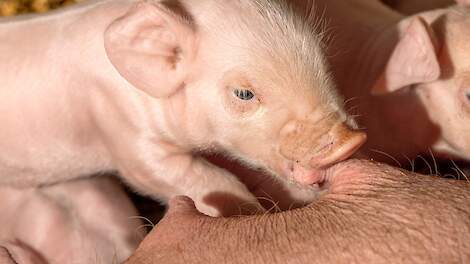Part 2 – Infectious Causes
The production number or the number of weaned piglets per sow per year is the most important key figure in sow farming and provides insight into the productivity of the sow herd. Piglet mortality in the farrowing pen has a negative impact on the production number and thus on the productivity of the sow herd. In this article we discuss the main infectious diseases that cause piglet mortality.
Diarrhea and intestinal infections
Within the infectious causes of pre-weaning piglet mortality, intestinal infections are by far the most important. Bacteria, viruses, parasites or a combination thereof can cause diarrhea in suckling piglets.
The main bacteria that cause farrowing diarrhea are Escherichia coli (E. coli) in Clostridium perfringens (C. perfringens) type A and type C. The problems mainly manifest themselves during the first week of life. Infections with E. coli are probably the most common cause of birth diarrhea. If left untreated, the infection quickly leads to dehydration and high mortality. C. perfringens type C produces toxins that break the blood vessels of the small intestine, allowing blood to leak into the small intestine. The condition is characterized by a high mortality rate. C. perfringens type A knows unlike C. perfringens type C has a milder course with less acute mortality, but with more weak piglets and offspring. Piglets can recover, but often become stragglers. Mortality can increase if infections with other pathogens occur at the same time or if the infection remains untreated.
Rotavirus infections are the main viral cause of diarrhea in suckling piglets. The symptoms are mainly characterized by a severe, watery diarrhea that quickly leads to dehydration.
Infections with Cystoisospora am (C. suis), the parasite that causes coccidiosis, are the main parasitic infections in farrowing pigs. Coccidiosis causes diarrhea and losses due to delayed and uneven growth. The problems are especially visible during the 2nd and 3rd week of life. Infections with C. am also cause a disturbance of the intestinal flora and can increase the clinical symptoms and losses due to other intestinal infections such as C. perfringens worsen type A.(1)
Other infections
In addition to intestinal infections, other infections, such as joint inflammation, meningitis, pneumonia, blood poisoning, … can also cause increased mortality in the farrowing pen.
The main viral infections endangering the health of unweaned piglets are infections with the PRRS virus and with the flu virus. Piglets can be infected with the PRRS virus already in the womb or shortly after birth. The symptoms include weak piglets with respiratory problems, lethargy and increased mortality.
Unlike PRRS, piglets are free of the flu virus at birth. On farms with persistent flu problems, the piglets often become infected in the farrowing pen. Influenza infections in suckling piglets can cause respiratory problems, but can also go unnoticed. In both cases, the piglets are a source of infection for the sow and their litter mates and are responsible for maintaining the circulation of the flu virus in the farm.
In addition to their direct harmful effects, PRRS and flu infections can also exacerbate the severity of other (bacterial) infections. For example, the flu virus has been shown to exacerbate the severity of streptococcal infections.(2,3) The flu virus ensures better attachment and multiplication of Streptococcus suis and helps the bacteria to enter the bloodstream more easily from the lungs and thus cause septicemia with the typical nerve symptoms and sudden death.
Conclusion
Within the infectious causes of piglet mortality, intestinal infections are by far the most important. In addition, other infections, such as joint inflammation, meningitis, pneumonia, blood poisoning, … can also cause increased mortality in the farrowing pen. An important role is played by infections with the PRRS virus and the flu virus. In addition to the direct harmful effects, these viruses can also amplify the severity of other infections. In a subsequent article, measures that can limit piglet mortality will be discussed in more detail.
Would you like to know more about the non-infectious causes of piglet mortality?
Read the article.
Sources
- Mengel et al. Necrotic enteritis due to simultaneous infection with Isospora am and clostridia in newborn piglets and its prevention by early treatment with toltrazuril. Parasitol. Res (2012) 110:1347–1355
- Wang et al. (2013). Capsular sialic acids of Streptocuckold am serotype 2 binds to swine influenza virus and enhances bacterial interactions with virus-infected tracheal epithelial cells. Infection and immunity.
- Meng et al. (2015). Dynamic virus-bacterium interactions in a porcine precision-cut lung slice coinfection model: swine influenza virus paves the way for the Streptocuckold am infection in a two-step process. Infection and immunity.
2023-05-26 06:00:00
#Ceva #Limit #piglet #mortality #Recognize #Pigbusiness.nl #News #pig #farmers


